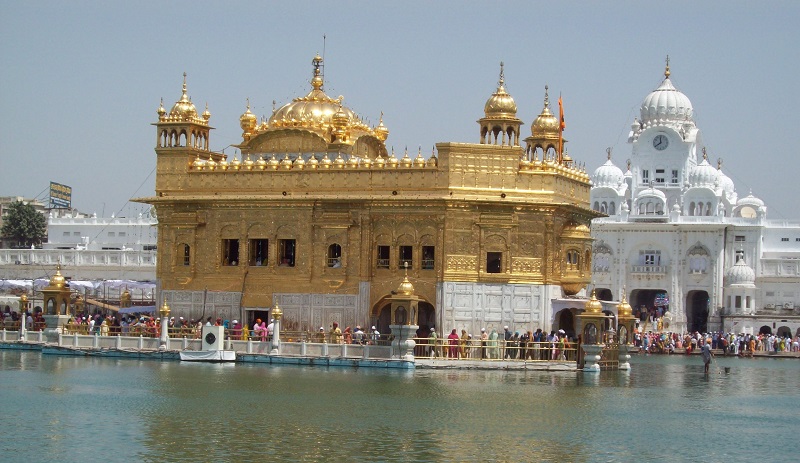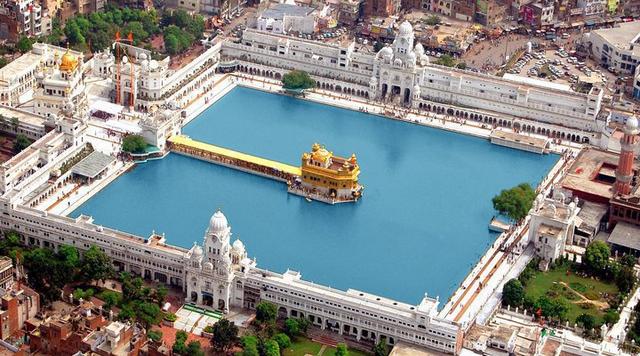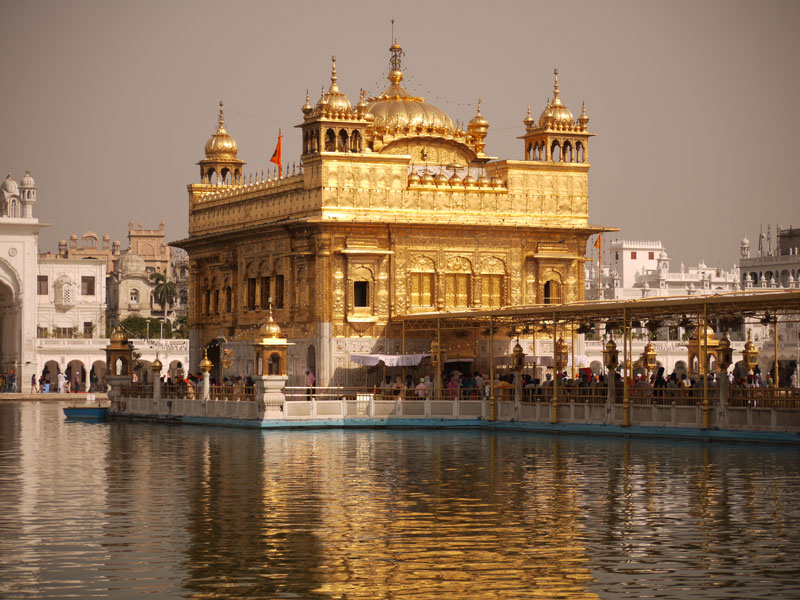Golden Temple, Amritsar
The Golden Temple, formally known as Sri Harmandir Sahib, is a Sikh Gurdwara in the city of Amritsar, Punjab, India.
It was built as a place of worship for all religions, and is considered the holiest Gurdwara of Sikhism. The symbolic openness of the Sikhs is represented by the four entrances used to enter the Gurdwara. It also includes the world’s largest free kitchen, capable of serving food to 300,000 people a day.
The structure dates back to the 16th century, when the site was acquired from the landlords of local villages, with the intention of establishing a new town settlement. Excavation of the 22,943.25 sq.m lake known as a Sarovar (the tank) but actually called Amritsar (Pool of the Nectar of Immortality) began in 1570, and gave the name to the city that developed around it. The tank was intended to be God’s home and whoever bathed in it would obtain spiritual and temporal advantages. It is fed by the Ravi River.
The normal custom had been for a Gurdwara to be built on high land; however, it was decided to build at a lower level so that worshippers would have to descend steps to enter it.
Construction was completed in 1604.
The temple is built on a 4177 sq. ft platform and is approached by a causeway of roughly 60 m in length. The Darshani Deorhi Arch stands at the beginning of the causeway, measuring 6.2 m (20.3 ft) high and 6 m (20 ft) wide.
The main structure is three storeys high. The bridge-facing front is decorated with repeated cusped arches. At the top of the first floor, 4 ft-high parapets rise on all sides. Balconied windows project on carved brackets or bay windows with shallow elliptical cornices.
A low-fluted golden dome sits at the top, with a lotus petal motif in relief at the base. There are also several miniature fluted domes covered with gilded copper.
Inside the Gurdwara memorial plaques commemorate past Sikh historical events, martyrs and saints.
The temple had to undergo substantial rebuilding in the 1760s, after it was attacked by the Afghan army. In the early-19th century, Maharaja Ranjit Singh secured the Punjab region from further attack and set about covering the Gurdwara’s upper floors with 750 kg of gold gilding and marblework, providing the temple with its distinctive appearance. The gold plating was completed in 1830.
[edit] Related articles on Designing Buildings Wiki
- Angkor Wat.
- Building of the week series.
- Dome of the Rock.
- El Castillo.
- Forbidden City.
- Great Mosque of Djenne.
- India looks at using plastic instead of sand.
- India needs to build more infrastructure fast. Here's how.
- Indian construction industry.
- Indian infrastructure.
- Hagia Sophia.
- Mahabat Maqbara, India.
- Shah Cheragh, Iran.
- Taj Mahal.
- Vastu Shastra.
- Vrindavan Chandrodaya Mandir.
Featured articles and news
Latest Build UK Building Safety Regime explainer published
Key elements in one short, now updated document.
UKGBC launch the UK Climate Resilience Roadmap
First guidance of its kind on direct climate impacts for the built environment and how it can adapt.
CLC Health, Safety and Wellbeing Strategy 2025
Launched by the Minister for Industry to look at fatalities on site, improving mental health and other issues.
One of the most impressive Victorian architects. Book review.
Common Assessment Standard now with building safety
New CAS update now includes mandatory building safety questions.
RTPI leader to become new CIOB Chief Executive Officer
Dr Victoria Hills MRTPI, FICE to take over after Caroline Gumble’s departure.
Social and affordable housing, a long term plan for delivery
The “Delivering a Decade of Renewal for Social and Affordable Housing” strategy sets out future path.
A change to adoptive architecture
Effects of global weather warming on architectural detailing, material choice and human interaction.
The proposed publicly owned and backed subsidiary of Homes England, to facilitate new homes.
How big is the problem and what can we do to mitigate the effects?
Overheating guidance and tools for building designers
A number of cool guides to help with the heat.
The UK's Modern Industrial Strategy: A 10 year plan
Previous consultation criticism, current key elements and general support with some persisting reservations.
Building Safety Regulator reforms
New roles, new staff and a new fast track service pave the way for a single construction regulator.
Architectural Technologist CPDs and Communications
CIAT CPD… and how you can do it!
Cooling centres and cool spaces
Managing extreme heat in cities by directing the public to places for heat stress relief and water sources.
Winter gardens: A brief history and warm variations
Extending the season with glass in different forms and terms.
Restoring Great Yarmouth's Winter Gardens
Transforming one of the least sustainable constructions imaginable.


























Comments
You written that temple is built on 67 square feet platform does not seem right. Also the size of Sarovar is 22,943.25 square m. Not 150 square m.
67ft x 67ft and 150m x 150m